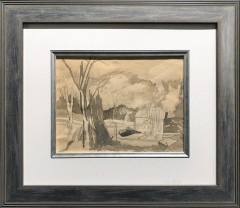John Northcote Nash RA (1893 - 1977)
- Sorry, this product cannot be purchased.
Showing the single result
John Northcote Nash
John Northcote Nash RA (1893 – 1977), the son of a barrister and younger brother of the war artist Paul Nash. (1889-1946) was born at Ghuznee Lodge, in Kensington, London in 1893. In 1901 his family returned to Buckinghamshire. Where the garden of Wood Lane House at Iver Heath and the countryside of the Chiltern Hills greatly influenced him. Educated at Wellington College, John started work as a trainee journalist but his life changed when his brother. (Paul Nash) who had enrolled at the Slade, brought home two fellow students, Claughton Pellew and Dora Carrington, who inspired him to become an artist. Dora also introduced him to his future wife Christine Kuhlensthal. (1895-1976), a talented artist who trained at the Slade with Paul Nash in the years immediately preceding World War One. They married in 1918.
Nash did not receive any formal training. Following his brother’s advice that it would ruin his unique vision of landscape. It would be unfair however to describe John Nash as an amateur artist. Especially after the notable success of his first exhibition in 1913 at the Dorien Leigh Gallery in Pelham Street in London. While exhibiting with the Camden Town Group (1913-14) and soon after in 1915 with the London Group at the Goupil Gallery John met with equal success.
During the First World War, in 1916, Nash joined the ‘Artists Rifles’. Before becoming an Official War Artist in 1918. From 1919 he then lived at Whiteleaf in Buckinghamshire where he became part of the renaissance of English book illustration. The drawings and engravings of this period especially reveal Nash’s knowledge of literature and botany as can be seen in his illustration of Poisonous Plants published in1927. During that period Nash also produced comic drawings inspired by Edward Lear, whose work he had seen in the home of his aunt Gussie, one of Lear’s girlfriends.
During the 1920s Nash taught at the Ruskin School of Art in Oxford. He remained a teacher until the end of his life. Inspiring many, including some of the best artists of Kew Gardens. During most of the interwar years John Nash and his wife lived at Meadle in Buckinghamshire. From there both went on holidays all over England during which they filled numerous sketch books with pen, pencil and wash studies which developed into oil and watercolour compositions in their studio. Like Constable, Nash made annotations in these books about the weather on particular days.
Nash had a great passion for plants and his technique as a plant illustrator deserves special mention as he excelled in the field. He liked to use live specimen which sometimes was a problem when publishers asked for illustrations of plants which were not in season. He often used his garden, which was planted with a wide variety of plants such as roses. Irises, gentians and hellebores. John Nash had always been interested in botany even as a child he had won a Botany Prize and, like his friend Cedric Morris, called himself an ‘artist plantsman’.
In 1940 Nash was commissioned as an Official War Artist in the Royal Marines. A role he did not especially enjoy, preferring to paint the English landscape, which he did after the war. From 1922 Nash had made many visits to Essex and rented a summer cottage at Wormingford. Near Colchester and in 1945 he and his wife bought Bottengoms Farm where they lived until they died. When in Essex Nash taught at Colchester Art School and conducted yearly plant illustration courses at Flatford Mill.
Nash was one of the founders of Colchester Art Society and later the Society’s President. Serving from 1946 to 1977. Through exhibitions of his own work, he became closely connected with the Minories Art Gallery. And on his death bequeathed his personal library and several of his paintings as well as the engravings to the Trust. Which is now the Victor Batte-Lay Foundation.
Becoming ARA in 1940 and RA in 1951 Nash was also appointed a CBE in 1964 and in 1967. He was distinguished by being given the first ever retrospective exhibition of a living painter by the Royal Academy. Nash’s work can be found in many private and public collections. Such as the Tate Gallery, the Courtauld Institute of Art and the Fine Art Museums of San Francisco. Works by the artist can be seen on the online Catalogue of the Royal Academy of Art in London and the online catalogue of the Victor Batte Lay Trust Foundation, owner of the Minories Art Gallery in Colchester.
Nash loved painting landscapes, especially in the evening. It is a habit which both he and his brother Paul developed while they were War Artists. And could only paint for their own pleasure when their official work was done for the day. As can be seen here the similarities between John Nash’s watercolour work and that of both Eric Ravilious and Edward Bawden are evident. Both Ravilious and Bawden were close friends of Paul, John’s brother, who had studied with them at the Royal College of Art in the 1920s, hence the influence. The subtlety of colour and the tonal range they used was remarkable and perfectly suited to the ephemeral landscapes they painted. There is here a feeling of natural sympathy for an English landscape itself often impregnated with moisture. The structure of the painting, with its defining lines. Is also typical of landscapes painted by Nash who declared that, when looking at a landscape. He always saw its underlying abstract features, reminiscent of his brother’s Surrealist visions.



